
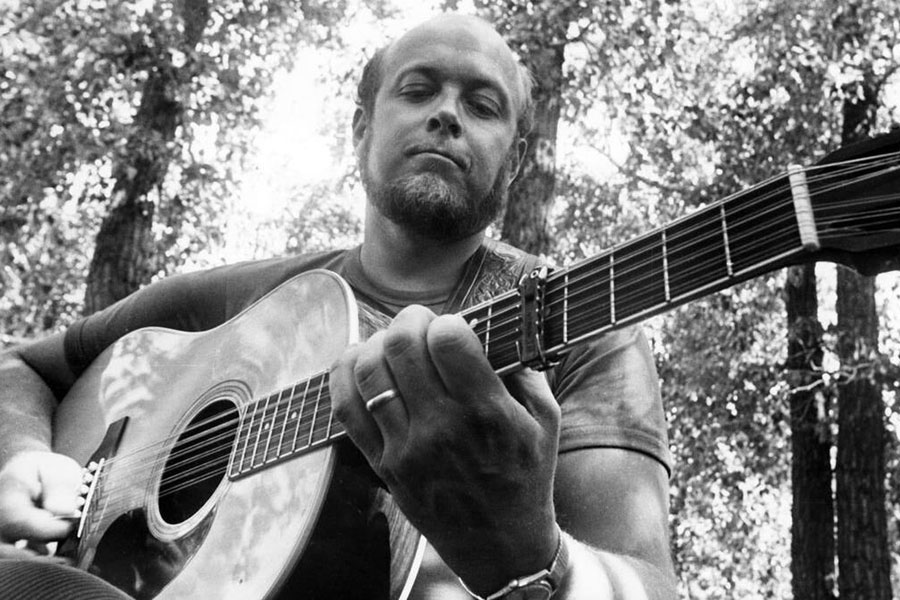
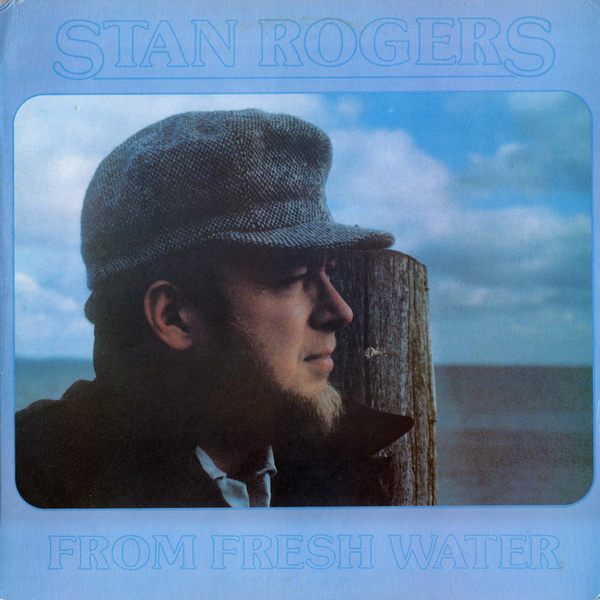
|
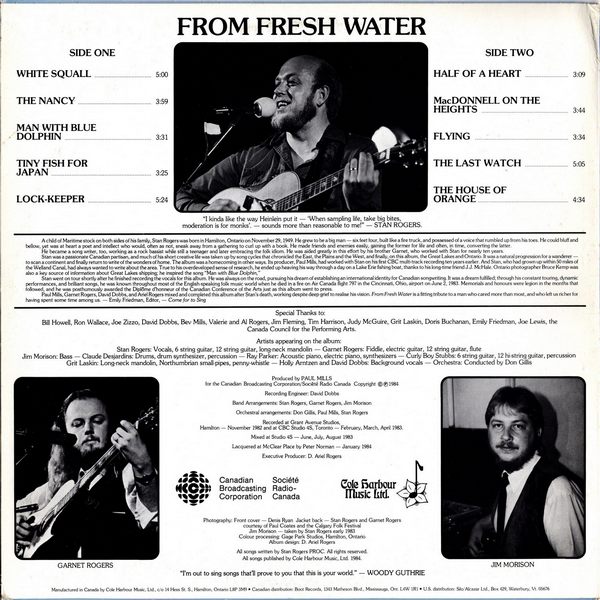
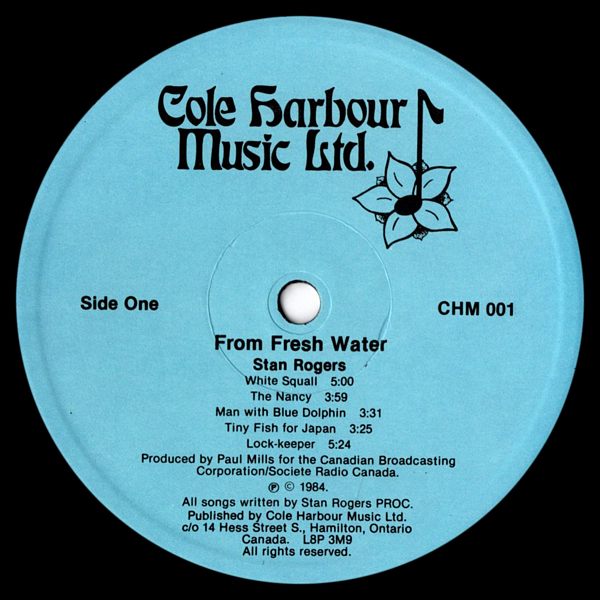
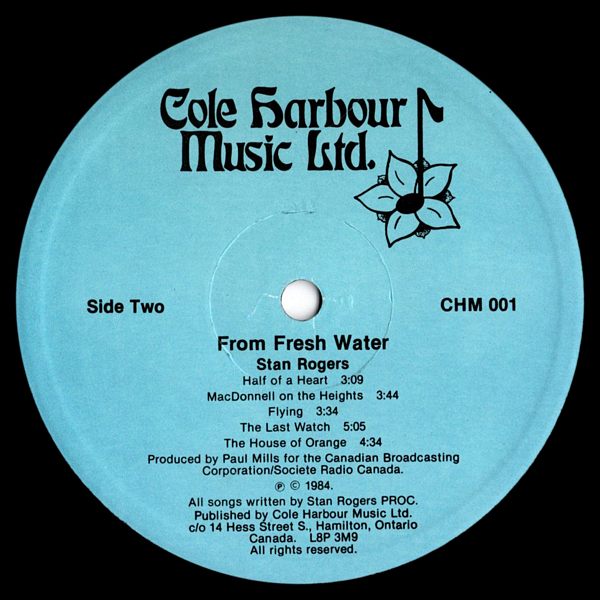
|
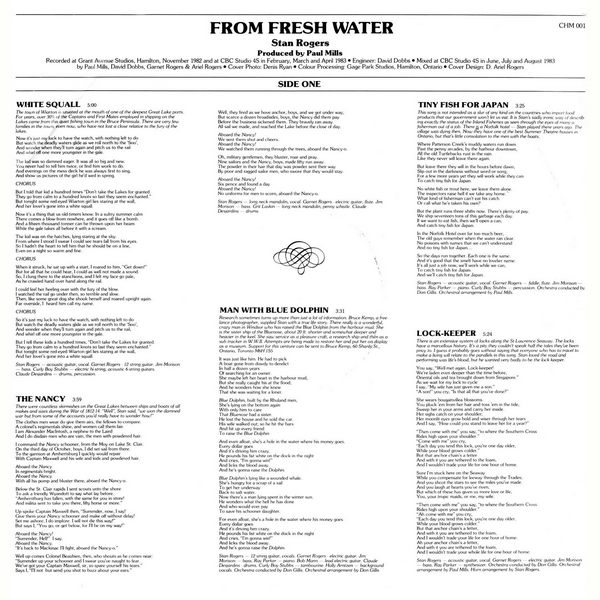
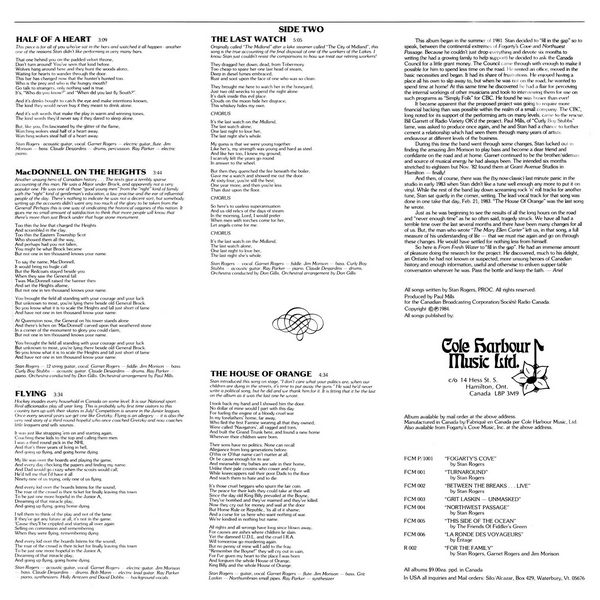
|
Sleeve Notes
"I kinda like the way Heinlein put it — 'When sampling life, take big bites, moderation is for monks'. — sounds more than reasonable to me!"
— STAN ROGERS.
This album began in the summer of 1981. Stan decided to "fill in the gap" so to speak, between the continental extremes of Fogarty's Cove and Northwest Passage. Because he couldn't just drop everything and devote six months to writing (he had a growing family to help support) he decided to ask the Canada Council for a little grant money. The Council came through with enough to make it possible for him to spend less time on the road. He rented an office, moved in the basic necessities and began. It had its share of frustrations. He enjoyed having a place all his own to slip away to, but when he was not on the road, he wanted to spend time at home! At this same time he discovered he had a flair (or perceiving the internal workings of other musicians and took to interviewing them (or use on such programs as "Simply Folk" for CBC. He found he was busier than ever!
It became apparent that the proposed project was going to require more financial backing than was possible within the realm of a small company. The CBC, long noted for its support of the performing arts on many levels, came to the rescue. Bill Garrett of Radio Variety OK'd the project. Paul Mills, of "Curly Boy Stubbs" fame, was asked to produce once again, and he and Stan had a chance to further cement a relationship which had seen them through many years of artistic endeavour at different levels of the business.
During this time the band went through some changes, Stan lucked out in finding the amazing Jim Morison to play bass and become a dear friend and confidante on the road and at home. Garnet continued to be the brother/sideman and source of musical energy he had always been. The intended six months stretched to eighteen but Nov. '82 found them at Grant Avenue Studios in Hamilton — finally!
And then, of course, there was the (by-now-classic) last-minute panic in the studio in early 1983 when Stan didn't like a tune well enough any more to put it on vinyl. While the rest of the band lay down screaming rock 'n' roll tracks for another tune, Stan sat quietly in the corner, writing. The lead vocal track for that song was done in one take that day, Feb. 21, 1983. "The House Of Orange" was the last song he wrote.
Just as he was beginning to see the results of all the long hours on the road and "never enough time" as he so often said, tragedy struck. We have all had a terrible time over the last several months and there have been many changes for all of us. But, the man who wrote "The Mary Ellen Carter" left us, in that song, a full measure of his understanding of life — that we must rise again and go on through these changes. He would have settled for nothing less from himself.
So here is From Fresh Water to "fill in the gap". He had an immense amount of pleasure doing the research for the project. He discovered, much to his delight, an Ontario he had not known or suspected, more unsung heroes of Canadian history and enough information, useful and otherwise to enliven supper table conversation wherever he was. Pass the bottle and keep the faith.
— Ariel
A child of Maritime stock on both sides of his family, Stan Rogers was born in Hamilton, Ontario on November 29, 1949. He grew to be a big man — six feet four, built like a fire truck, and possessed of a voice that rumbled up from his toes. He could bluff and bellow, yet was at heart a poet and intellect who would, often as not, sneak away from a gathering to curl up with a book. He made friends and enemies easily, gaining the former for life and often, in time, converting the latter.
He became a song writer, too, working as a rock bassist while still a teenager and later embracing the folk idiom. He was aided greatly in this effort by his brother Garnet, who worked with Stan for nearly ten years.
Stan was a passionate Canadian partisan, and much of his short creative life was taken up by song cycles that chronicled the East, the Plains and the West, and finally, on this album, the Great Lakes and Ontario. It was a natural progression for a wanderer — to scan a continent and finally return to write of the wonders of home. The album was a homecoming in other ways. Its producer, Paul Mills, had worked with Stan on his first CBC multi-track recording ten years earlier. And Stan, who had grown up within 50 miles of the Welland Canal, had always wanted to write about the area. True to his overdeveloped sense of research, he ended up heaving his way through a day on a Lake Erie fishing boat, thanks to his long-time friend J.J. 'McHale. Ontario photographer Bruce Kemp was also a key source of information about Great Lakes shipping; he inspired the song "Man with Blue Dolphin,"
Stan went on tour shortly after he finished recording the vocals for this album. He was always on the road, pursuing his dream of establishing an international identity for Canadian songwriting. It was a dream fulfilled; through his constant touring, dynamic performances, and brilliant songs, he was known throughout most of the English-speaking folk music world when he died in a fire on Air Canada flight 797 in the Cincinnati, Ohio, airport on June 2, 1983. Memorials and honours were legion in the months that followed, and he was posthumously awarded the Diplome d'honneur of the Canadian Conference of the Arts just as this album went to press.
Paul Mills, Garnet Rogers, David Dobbs, and Ariel Rogers mixed and completed this album after Stan's death, working despite deep grief to realise his vision. From Fresh Water is a fitting tribute to a man who cared more than most, and who left us richer for having spent some time among us.
Emily Friedman
Editor, — Come for to Sing